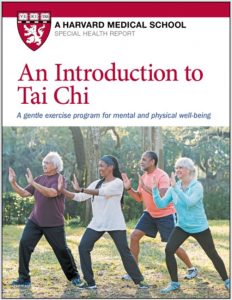 As an ancient Chinese practice, tai chi may seem foreign and even intimidating. Perhaps your only experience with tai chi is watching video clips or seeing photos of large groups of Chinese people doing tai chi in parks—a rare occurrence in the United States. Only about 1% of the U.S. population, or about 3.65 million Americans, reported doing tai chi in 2015. That means a lot of Americans are missing out on myriad benefits that tai chi has to offer. The goal of this report is to make tai chi more familiar, more accessible, and easy to practice regularly—even right in your living room.
As an ancient Chinese practice, tai chi may seem foreign and even intimidating. Perhaps your only experience with tai chi is watching video clips or seeing photos of large groups of Chinese people doing tai chi in parks—a rare occurrence in the United States. Only about 1% of the U.S. population, or about 3.65 million Americans, reported doing tai chi in 2015. That means a lot of Americans are missing out on myriad benefits that tai chi has to offer. The goal of this report is to make tai chi more familiar, more accessible, and easy to practice regularly—even right in your living room.
Mind-body exercises, such as tai chi and yoga, have been gaining popularity over the past few decades. This is not surprising, given the increasing number of studies on the positive effects of these gentler forms of exercise—everything from lowering blood pressure and managing depression to building strength and improving balance. There is even evidence that tai chi may help you live a longer, more vital life.
For roughly two decades, I’ve been working to bridge the gap between the practice and the science of tai chi and to integrate it into Western health care. By day, I am a medical researcher at Harvard Medical School, and by night, I am a community-based tai chi instructor.
My interest in tai chi grew out of a passion for sports and martial arts that started when I was in high school. It was during that time that I also became interested in science, which led me to study human ecology and get a Ph.D. in evolutionary biology from Harvard University. But it wasn’t until a trip to China in 2000 that my two worlds came together, and I made a major career shift, ultimately resulting in my current position as research director for the Osher Center for Integrative Medicine, which is jointly based at Harvard Medical School and Brigham and Women’s Hospital.
In my role as a scientist, I focus on objective, rigorous scientific research to understand what works, what doesn’t work, what is safe, and what offers promise to help people. Yet while I use research and science to inform my personal tai chi practice and the classes I teach, I must suspend pure rational thinking at times in order to get the most out of my practice. Tai chi and other meditative arts include tapping into intuition and imagination, processes less understood by science. In this report, I’ve brought these two worlds together to introduce you to tai chi and give you a program so you can begin practicing this gentle, mind-body exercise today.
Prepared by the editors of the Harvard Health Publishing in consultation with Peter M. Wayne, PhD, Associate Professor of Medicine, Harvard Medical School, Director of Research, Osher Center for Integrative Medicine. 45 pages. (2018)
https://www.health.harvard.edu/exercise-and-fitness/an-introduction-to-tai-chi

